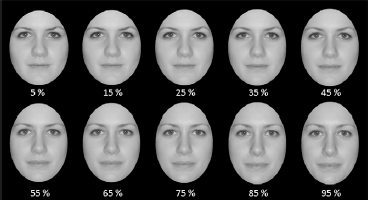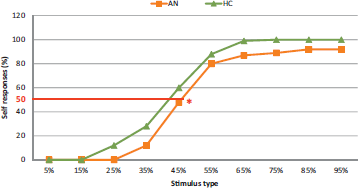Article contents
Decreased self-face recognition: A new evidence of body image disturbances in anorexia nervosa
Published online by Cambridge University Press: 16 April 2020
Abstract
Body image disturbances are core symptoms of Anorexia Nervosa (AN). This study investigated self-face recognition in cases of AN, and the influence of others factors associated with AN, such as massive weight loss.
Fifteen anorexic female patients and 15 matched Healthy Controls (HC) performed a self-face recognition task. Participants viewed digital morphs between their own face and a gender-matched, unfamiliar other face presented in a random sequence (Fig. 1). For each stimulus, subjects were asked if they recognized their own face, and respond by selectively pressing a button on a computer. Participants’ self-face recognition failures, cognitive flexibility, body concerns and eating habits were assessed, respectively, with the Self-Face Recognition Questionnaire (SFRQ), the Trail Marking Task (TMT), the Body Shape Questionnaire (BSQ) and the Eating Disorder Inventory-2 (EDI-2).
Fig. 1
Examples of stimulus. For each subject, a photograph of an unfamiliar face was digitally morphed into a photograph of the subject's face in 10% increments.

Anorexic patients showed a significantly greater difficulty than healthy control in identifying their own face (P = 0.028, Fig. 2). No significant difference was observed between the two groups for TMT (all P > 0.1). However, analysis did not reveal significant correlations between behavioral data and the EDI-2 or BSQ (all P > 0.1). A correlation analysis revealed a significant, negative correlation with BMI (P < 0.001) and the SFRQ “self-face recognition” subscale (P = 0.015).
Fig. 2
Self response rates per stimulus ranked in increasing order of familiarity (other to self) in both groups.

We observed a decrease in self-face recognition, correlated with BMI, suggesting this disturbance could be linked to massive weight loss. It thus supports the theory of a lack of ability to update body image by the central nervous system, underlying self-images distortion in AN patients.
Information
- Type
- Posters
- Information
- European Psychiatry , Volume 28 , Issue S2: Hors-série 1 – 5ème Congrès Français de Psychiatrie – Nice, novembre 2013 , November 2013 , pp. 24
- Copyright
- Copyright © European Psychiatric Association 2013
References
Further reading
- 1
- Cited by


Comments
No Comments have been published for this article.